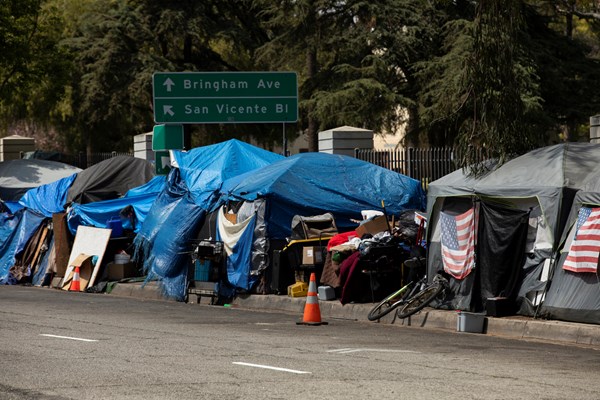SB 1152: An Ongoing Effort to Improve Quality of Care for Unhoused Patients in the ED
Patients experiencing homelessness (PEH) visit the emergency department (ED) at disproportionately high rates. PEH are at a greater risk of "patient dumping" - being prematurely discharged from the hospital, often to a homeless encampment or the street. In response, the state of California enacted Senate Bill (SB) 1152 in 2019, requiring medical providers to ensure that PEH are offered "transportation to a location of the patient's choice, a meal, weather-appropriate clothing, an adequate supply of medications, appropriate infectious disease screening and vaccinations, referrals to follow-up medical care, referral for follow-up behavioral health care (if necessary), health insurance resources, and housing resources" prior to hospital discharge – including from the ED.
A mixed-methods study by Taira et al. (2022) evaluates the ability of 3 emergency departments in Los Angeles County to meet the requirements established by SB 1152. The authors performed a retrospective electronic health record review of 52,607 records, followed by qualitative interviews of 25 ED providers to contextualize the findings.
The majority of encounters with PEH did not fulfill all SB 1152 requirements. PEH were provided prescriptions in only 9% of encounters. Conversely, social work consultation was the most commonly completed component of SB 1152 and was documented in 33.9% of encounters. During their interviews, providers shared that while they try to fill medications relevant to the ED visit, they do not typically ask about medications for unrelated chronic health conditions. Another provider explained that they become familiar with the needs and preferences of some PEH who visit regularly (eg, some PEH may not be interested in shelter resources), obviating the need for social work consultation at each ED visit.
The study identified several challenges reflecting the incongruence between some of the requirements outlined in SB 1152 and the function of an ED, including the administration of routine vaccinations; the lack of funding to provide necessary social resources; and public perception of the ED as a primary source for food, clothing, and housing. Limitations of this study included researchers' inability to interview PEH receiving services under SB 1152, data collection over a short two-month period within one healthcare system, and the possibility that provider interviews influenced compliance rates.
Overall, SB 1152 has drawn attention to the need to standardize safe discharges of PEH. However, homelessness is a complex problem that cannot be solved solely through ED disposition planning. The authors of this article advocate for:
- The clarification of SB 1152 requirements for inpatient versus ED discharges;
- State funding to help hospitals enact SB 1152 services and support housing-focused case workers;
- Legislation to increase shelter and housing capacity for hospital-discharged PEH, as well as to address systemic causes of poverty and homelessness themselves.
ABSTRACT
Taira BR, Kim H, Tlatelpa Prodigue K, et al. A mixed methods evaluation of interventions to meet the requirements of California Senate Bill 1152 in the emergency departments of a public hospital system. Milbank Q. 2022;100(2):464-491.
Background:
Policy Points Clarifications to Senate Bill (SB) 1152 are necessary to address the differences between inpatient and emergency department (ED) discharge processes, determine how frequently an ED must deliver the SB 1152 bundle of services to a single patient, and establish expectations for compliance during off-hours when social services are unavailable. Because homelessness cannot be resolved in a single ED visit, the state should provide funding to support housing-focused case workers that will follow patients experiencing homelessness (PEH) through the transition from temporary shelters to permanent supportive housing. Medi-Cal could fund the delivery of the SB 1152 bundle of services to defray the costs to public hospitals that provide care for high numbers of PEH. California legislators should consider complementary legislation to increase funding for shelters so that sufficient capacity is available to accept PEH from EDs and hospitals, and to fund alternative strategies to prevent poverty and the upstream root causes of homelessness itself.
Context: Prompted by stories of "patient dumping," California enacted Senate Bill (SB) 1152, which mandates that hospitals offer patients experiencing homelessness (PEH) a set of resources at discharge to ensure safety and prevent dumping.
Methods: To evaluate interventions to meet the requirements of SB 1152 across three emergency departments (EDs) of a Los Angeles County public hospital system with a combined annual census of 260,000 visits, we used an explanatory sequential mixed methods approach, focusing first on quantitative evaluation and then using information from qualitative interviews to explain the quantitative findings
Findings
In total, 2.9% (1,515/52,607) of encounters involved PEH. Documentation of compliance with the eight required components of SB 1152 was low, ranging from 9.0% to 33.9%. Twenty-five provider interviews confirmed support for providing assistance to PEH in the ED, but the participants described barriers to compliance, including challenges in implementing universal screening for homelessness, incongruity of the requirements with the ED setting, the complexity of the patients, and the limitations of SB 1152 as a health policy.
Conclusion
Despite operationalizing universal screening for homelessness, we found poor compliance with SB 1152 and identified multiple barriers to implementation.
EMRA + PolicyRx Health Policy Journal Club: A collaboration between Policy Prescriptions and EMRA
 As emergency physicians, we care for all members of society, and as such have a unique vantage point on the state of health care. What we find frustrating in our EDs - such as inadequate social services, the dearth of primary care physicians, and the lack of mental health services - are universal problems. As EM residents and fellows, we learn the management of myocardial infarctions and traumas, and how to intubate, but we are not taught how health policy affects all aspects of our experience in the ED. Furthermore, given our unique position in the health care system, we have an incredible opportunity to advocate for our patients, for society, and for physicians. Yet, with so many competing interests vying for our conference education time, advocacy is often not included in the curricula. This is the gap this initiative aims to fill. Each month, you will see a review of a new health policy article and how it is applicable to emergency physicians.
As emergency physicians, we care for all members of society, and as such have a unique vantage point on the state of health care. What we find frustrating in our EDs - such as inadequate social services, the dearth of primary care physicians, and the lack of mental health services - are universal problems. As EM residents and fellows, we learn the management of myocardial infarctions and traumas, and how to intubate, but we are not taught how health policy affects all aspects of our experience in the ED. Furthermore, given our unique position in the health care system, we have an incredible opportunity to advocate for our patients, for society, and for physicians. Yet, with so many competing interests vying for our conference education time, advocacy is often not included in the curricula. This is the gap this initiative aims to fill. Each month, you will see a review of a new health policy article and how it is applicable to emergency physicians.



